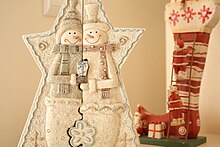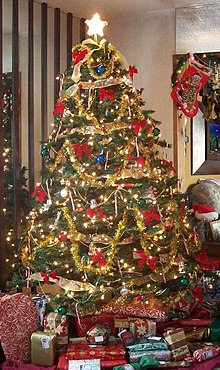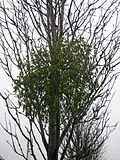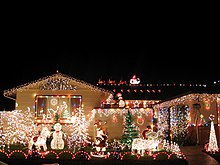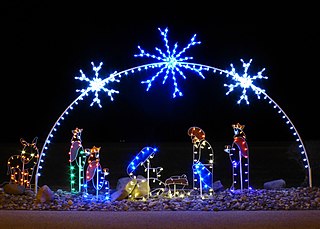
Christmas is an annual festival commemorating the birth of Jesus Christ, observed primarily on December 25 as a religious and cultural celebration among billions of people around the world. A feast central to the liturgical year in Christianity, it follows the season of Advent or the Nativity Fast, and initiates the season of Christmastide, which historically in the West lasts twelve days and culminates on Twelfth Night. Christmas Day is a public holiday in many countries, is celebrated religiously by a majority of Christians, as well as culturally by many non-Christians, and forms an integral part of the holiday season surrounding it.

A Christmas tree is a decorated tree, usually an evergreen conifer, such as a spruce, pine or fir, or an artificial tree of similar appearance, associated with the celebration of Christmas.

Advent is a season observed in most Christian denominations as a time of expectant waiting and preparation for both the celebration of the Nativity of Christ at Christmas and the return of Christ at the Second Coming. Advent is the beginning of the liturgical year in Western Christianity. The name was adopted from Latin adventus "coming; arrival", translating Greek parousia from the New Testament, originally referring to the Second Coming.

A wreath is an assortment of flowers, leaves, fruits, twigs, or various materials that is constructed to form a ring shape.
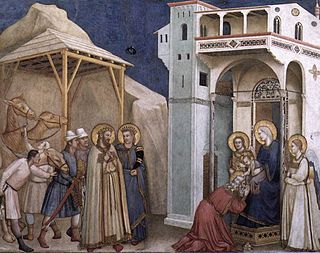
The Twelve Days of Christmas, also known as the Twelve Days of Christmastide, are the festive Christian season celebrating the Nativity.

The Advent wreath, or Advent crown, is a Christian tradition that symbolizes the passage of the four weeks of Advent in the liturgical calendar of the Western church. It is traditionally a Lutheran practice, although it has spread to many other Christian denominations.
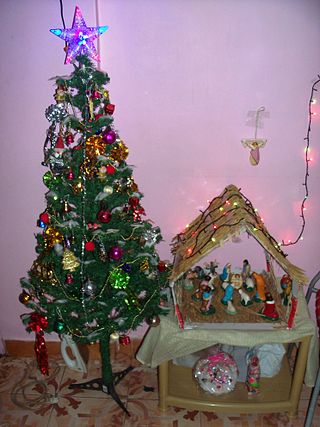
Christmastide, also known as Christide, is a season of the liturgical year in most Christian churches.
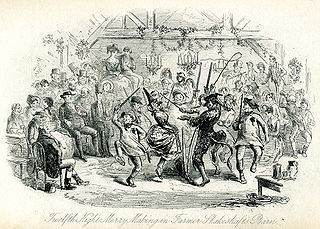
Twelfth Night is a Christian festival on the last night of the Twelve Days of Christmas, marking the coming of the Epiphany. Different traditions mark the date of Twelfth Night as either 5 January or 6 January, depending on whether the counting begins on Christmas Day or 26 December. January 6 is celebrated as the feast of Epiphany, which begins the Epiphanytide season.

An Advent calendar, from the German word Adventskalender, is used to count the days of Advent in anticipation of Christmas. Since the date of the First Sunday of Advent varies, falling between November 27 and December 3 inclusive, many reusable Advent calendars made of paper or wood begin on December 1. Others start from the First Sunday of Advent.

Christmas lights are lights often used for decoration in celebration of Christmas, often on display throughout the Christmas season including Advent and Christmastide. The custom goes back to when Christmas trees were decorated with candles, which symbolized Christ being the light of the world. The Christmas trees were brought by Christians into their homes in early modern Germany.

Christmas ornaments, baubles, globes, "Christmas bulbs", or "Christmas bubbles" are decoration items, usually to decorate Christmas trees. These decorations may be woven, blown, molded, carved from wood or expanded polystyrene, or made by other techniques.

Candlemas, also known as the Feast of the Presentation of Jesus Christ, the Feast of the Purification of the Blessed Virgin Mary, or the Feast of the Holy Encounter, is a Christian holiday commemorating the presentation of Jesus at the Temple. It is based upon the account of the presentation of Jesus in Luke 2:22–40. Under Leviticus 12, a woman was to be purified by presenting a lamb as a burnt offering, and either a young pigeon or dove as sin offering, 33 days after a boy's circumcision. It falls on 2 February, which is traditionally the 40th day of and the conclusion of the Christmas–Epiphany season. While it is customary for Christians in some countries to remove their Christmas decorations on Twelfth Night, those in other Christian countries historically remove them after Candlemas. On Candlemas, many Christians also take their candles to their local church, where they are blessed and then used for the rest of the year; for Christians, these blessed candles serve as a symbol of Jesus Christ, who is the Light of the World.

An Advent candle is a candle marked with the days of December up to Christmas Eve. It is typically used in a household rather than a church setting: each day in December the candle is burnt down a little more, to the mark for the day, to show the passing of the days leading up to Christmas. As with reusable Advent calendars, some Advent candles start marking the days from 1 December, rather than the exact beginning of Advent. Some households will make a Christmas decoration out of sprigs of evergreen and Christmas ornaments, with the candle at its center; others will simply put it in a candlestick. It is usually burned at the family evening meal each day.

Christmas pyramids are Christmas decorations that have their roots in the folklore and customs of the Ore Mountain region of Germany, but which have become popular internationally. They comprise a decorated pyramidal outer frame with candle holders and a central carousel with a rotor at the top which is driven by warm air from the lit candles. The carousel is decorated with nativity scenes and other Christmas figures such as angels and wise men, as well as worldly motifs such as mining folk and forest scenes.

Advent Sunday, also called the First Sunday of Advent or First Advent Sunday, among the Western Christian Churches, is the first day of the liturgical year and the start of the season of Advent.
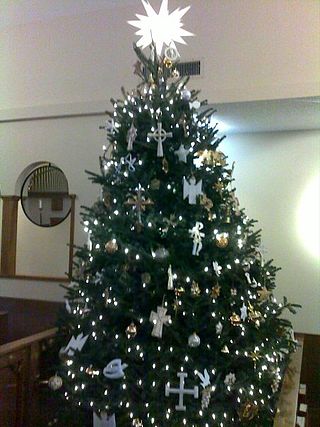
A Chrismon tree is an evergreen tree often placed in the chancel or nave of a church during Advent and Christmastide. The Chrismon tree was first used by North American Lutherans in 1957, although the practice has spread to other Christian denominations, including Anglicans, Catholics, Methodists, and the Reformed. As with the ordinary Christmas tree, the evergreen tree itself, for Christians, "symbolizes the eternal life Jesus Christ provides". However, the Chrismon tree differs from the traditional Christmas tree in that it "is decorated only with clear lights and Chrismons made from white and gold material", the latter two being the liturgical colours of the Christmas season.
Christmas plants are flowers or vegetation from garden plants associated with the festive season of Christmas. There are also a wide variety of plants that include "Christmas" in their common name.

The hanging of the greens is a Western Christian ceremony in which many congregations and people adorn their churches, as well as other buildings, with Advent and Christmas decorations. This is done on or directly before the start of the Advent season, in preparation for Christmastide. The service involves the placement of evergreen vegetation in the parish. Items such as the evergreen wreath, in Christianity, carry the religious symbolism of everlasting life, a theological concept within that faith. As such, during the liturgy, "Biblical passages and other readings help explain the significance of the holly, the cedar, the Advent wreath, the Chrismon tree, and any other special decorations". Christmas trees are frequently erected during the hanging of the greens, although they are sometimes left bare until Christmas Eve.

Christmas in France is a major annual celebration, as in most countries of the Christian world. Christmas is celebrated as a public holiday in France on December 25, concurring alongside other countries.

Christmas traditions include a variety of customs, religious practices, rituals, and folklore associated with the celebration of Christmas. Many of these traditions vary by country or region, while others are practiced virtually identically worldwide.

